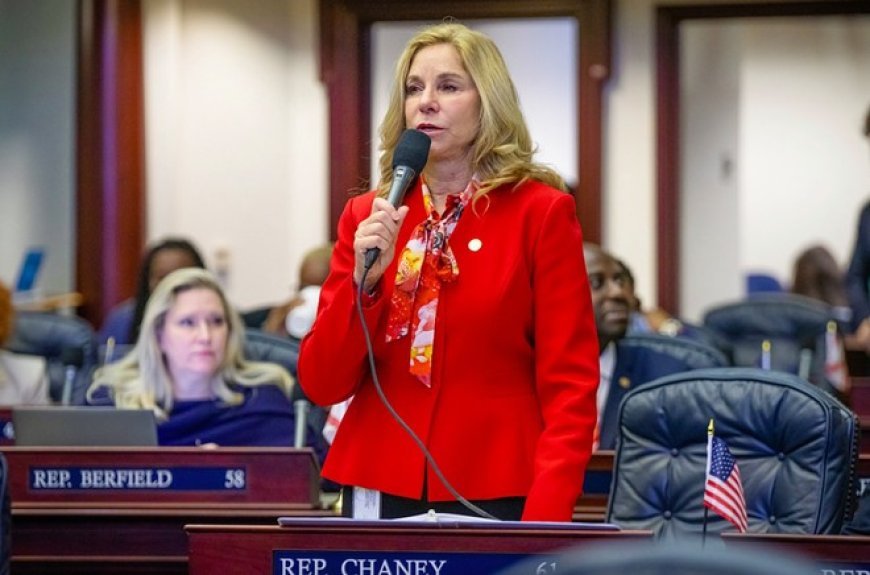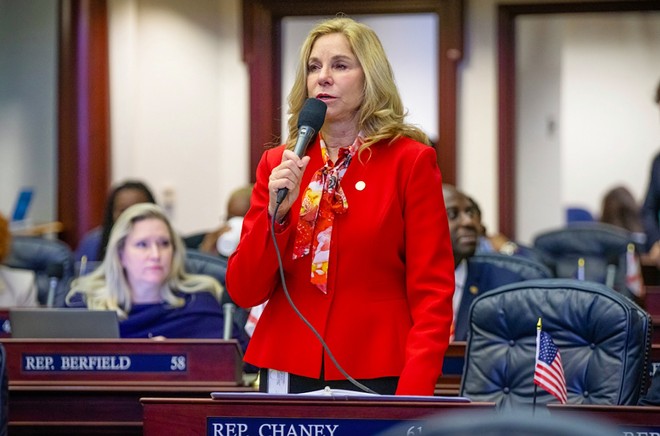A billionaire-backed conservative think tank is trying to roll back Florida child labor law
A billionaire-backed conservative think tank is trying to roll back Florida child labor law Orlando Weekly

A Conservative Think Tank in Florida Seeks to Relax Child Labor Laws

Photo via Florida House of Representatives
Rep. Linda Chaney, R-St. Pete Beach
A conservative think tank in Florida that has lobbied Republicans in state legislatures across the country to relax child labor laws has also written legislation to accomplish a similar aim in Florida, according to new records. The bill, filed by Florida Republican Linda Chaney, aims to loosen restrictions on how late older teens in Florida can work and prevent local governments from passing stricter limitations than the state’s regulations. This bill aligns with the Sustainable Development Goal 8: Decent Work and Economic Growth, as it seeks to address labor shortages and provide flexibility for teenagers to work and earn money while assisting small businesses.
The Influence of the Foundation for Government Accountability
It has been suspected that the Foundation for Government Accountability (FGA), a Naples-based group that has drafted legislation to roll back child labor laws in other states, is behind Chaney’s bill. Public records, including emails and text messages, obtained by More Perfect Union confirm this suspicion. The FGA, funded by ultra-conservatives and a billionaire mega-donor, not only supports Chaney’s bill but also wrote it themselves. They provided talking points to counter the backlash the bill received.
Rollbacks of Child Labor Regulations in Multiple States
The FGA has directly lobbied Republicans in states like Arkansas, Missouri, and Iowa to relax regulations on child labor laws. At least 16 states, including Florida, have introduced legislation to roll back child labor regulations in the past two years. These proposals aim to extend work hours, lift age requirements for serving alcohol, and allow minors to work in hazardous jobs. While Florida’s bill is not as extreme as some others, it still seeks to remove restrictions on the working hours of 16-year-olds and 17-year-olds.
Potential Negative Effects of Child Labor
Child experts argue that putting minors to work for more than 20 hours per week can have negative effects on their academic performance and increase the risk of behavioral problems. They cite studies that show a correlation between excessive work hours and issues such as drug use and school absenteeism. Therefore, it is crucial to consider the potential consequences of relaxing child labor regulations.
Increase in Child Labor Violations in Florida
Florida has seen a significant increase in child labor violations in recent years. According to the U.S. Department of Labor, the number of child labor violations in the state nearly tripled from 2019 to 2022. This rise in violations can be attributed to various factors, including labor shortages, an influx of unaccompanied minors seeking work, and high inflation pushing more teens into the labor market. It is essential to address these violations and protect minors from hazardous work and exploitation.
The Role of Lobbyists and Proposed Changes to State Laws
Emails and text messages exchanged between Chaney’s office and lobbyists reveal the close involvement of the FGA’s Opportunity Solutions Project in drafting the bill. Lobbyists provided draft language for the legislation and offered talking points to support its passage. Advocates are concerned that proposed changes to state laws, including the relaxation of child labor regulations, could weaken existing protections under federal law. It is crucial to prioritize the safety and well-being of minors when considering such changes.
Other Agendas of the Foundation for Government Accountability
The FGA has been involved in various policy areas beyond child labor rollbacks. They have fought against expanding Medicaid, supported efforts to tighten eligibility requirements for food stamps, and undermined labor unions. Their influence extends to multiple states, with significant lobbying expenditures in Florida alone.
Conclusion
The child labor bill proposed by Florida Republican Linda Chaney, with the support and involvement of the Foundation for Government Accountability, raises concerns about the potential impact on minors and their well-being. It is crucial to prioritize the Sustainable Development Goals, particularly Goal 8: Decent Work and Economic Growth, while considering changes to labor regulations. Protecting children from hazardous work and exploitation should be a priority for lawmakers and policymakers.
SDGs, Targets, and Indicators Analysis
1. Which SDGs are addressed or connected to the issues highlighted in the article?
- SDG 8: Decent Work and Economic Growth
- SDG 4: Quality Education
- SDG 10: Reduced Inequalities
The article discusses the proposed bill in Florida that aims to relax child labor regulations. This issue is connected to SDG 8, which focuses on promoting sustained, inclusive, and sustainable economic growth, full and productive employment, and decent work for all. It is also connected to SDG 4, which aims to ensure inclusive and equitable quality education and promote lifelong learning opportunities for all. Additionally, the issue relates to SDG 10, which seeks to reduce inequalities within and among countries.
2. What specific targets under those SDGs can be identified based on the article’s content?
- Target 8.7: Take immediate and effective measures to eradicate forced labor, end modern slavery and human trafficking, and secure the prohibition and elimination of the worst forms of child labor.
- Target 4.5: By 2030, eliminate gender disparities in education and ensure equal access to all levels of education and vocational training for the vulnerable, including persons with disabilities, indigenous peoples, and children in vulnerable situations.
- Target 10.7: Facilitate orderly, safe, regular, and responsible migration and mobility of people, including through the implementation of planned and well-managed migration policies.
Based on the article’s content, the specific targets that can be identified are Target 8.7, which focuses on eradicating forced labor and child labor, Target 4.5, which aims to eliminate gender disparities in education, and Target 10.7, which aims to facilitate safe and responsible migration.
3. Are there any indicators mentioned or implied in the article that can be used to measure progress towards the identified targets?
- Indicator 8.7.1: Proportion and number of children aged 5-17 years engaged in child labor, by sex and age group.
- Indicator 4.5.1: Parity indices (female/male, rural/urban, bottom/top wealth quintile, and others such as disability status, indigenous peoples, and conflict-affected, as data become available) for all education indicators on access, participation, and achievement in formal and non-formal education.
- Indicator 10.7.1: Recruitment cost borne by employee as a proportion of yearly income earned in country of destination.
The article does not explicitly mention indicators, but based on the identified targets, the following indicators can be used to measure progress:
– Indicator 8.7.1 can be used to measure the proportion and number of children engaged in child labor.
– Indicator 4.5.1 can be used to measure gender disparities in education and access to education for vulnerable groups.
– Indicator 10.7.1 can be used to measure the recruitment cost borne by employees as a proportion of their yearly income in the destination country.
Table: SDGs, Targets, and Indicators
| SDGs | Targets | Indicators |
|---|---|---|
| SDG 8: Decent Work and Economic Growth | Target 8.7: Take immediate and effective measures to eradicate forced labor, end modern slavery and human trafficking, and secure the prohibition and elimination of the worst forms of child labor. | Indicator 8.7.1: Proportion and number of children aged 5-17 years engaged in child labor, by sex and age group. |
| SDG 4: Quality Education | Target 4.5: By 2030, eliminate gender disparities in education and ensure equal access to all levels of education and vocational training for the vulnerable, including persons with disabilities, indigenous peoples, and children in vulnerable situations. | Indicator 4.5.1: Parity indices (female/male, rural/urban, bottom/top wealth quintile, and others such as disability status, indigenous peoples, and conflict-affected, as data become available) for all education indicators on access, participation, and achievement in formal and non-formal education. |
| SDG 10: Reduced Inequalities | Target 10.7: Facilitate orderly, safe, regular, and responsible migration and mobility of people, including through the implementation of planned and well-managed migration policies. | Indicator 10.7.1: Recruitment cost borne by employee as a proportion of yearly income earned in country of destination. |
Behold! This splendid article springs forth from the wellspring of knowledge, shaped by a wondrous proprietary AI technology that delved into a vast ocean of data, illuminating the path towards the Sustainable Development Goals. Remember that all rights are reserved by SDG Investors LLC, empowering us to champion progress together.
Source: orlandoweekly.com

Join us, as fellow seekers of change, on a transformative journey at https://sdgtalks.ai/welcome, where you can become a member and actively contribute to shaping a brighter future.







